["Christian" leadership
stating that Jews are better observing - influence on the
"Christian" population - racist Church legislation against
the Jews - First Crusade of 1096 and massacres and suicides]
<Jews had appeared in western Europe from the beginning of
the Christian era. At the commencement of the Middle Ages, no
sign of singular animosity toward them was discernible [[was
to see]]. The clerical anti-Jewish polemics of the period
deplored the influence the Jews exerted on the people, and
pointed to the existence of cordial, sometimes intimate,
Judeo-Christian relations. Characteristic are the epistles of
the ninth-century Christian reformer Archbishop *Agobard:
"Things have reached a stage where ignorant Christians claim
that the Jews preach better than our priests ... some
Christians even celebrate the Sabbath with the Jews and
violate the holy repose of Sunday ... Men of the people,
peasants, allow themselves to be plunged into such a sea of
errors that they regard the Jews as the only people of God,
and consider that they combine the observance of a pure
religion and a truer faith than ours."
The *Church Councils continually legislated to prevent these
contacts. Ecclesiastical propaganda seems to have produced its
first fruits at the beginning of the 11th century, when
persecutions and expulsions were recorded in Rouen, Orleans,
Limoges, and Main. A persecution inflicted at the time on
Christians in the Orient was used as a pretext, and,
apparently dating from the same period is the fable depicting
the Jews as legionaries of the Anti-Christ.
However, the crucial event was the First Crusade (1096).
Religious excitation commingled with greed for gain. As bands
of crusaders set out to recapture the sepulcher of Jesus they
were prompted to wreak vengeance on Jesus' legendary enemies,
and attacked the Jewish quarters of German and French towns
along their way. The massacres perpetrated during the summer
of 1096 made a lasting impression on both Christians and Jews.
The tradition of sacrifice, *Kiddush ha-Shem, was expressed in
collective suicides to avoid forced conversion [[and to avoid
the stake]]. (col. 101)
[Guilds without Jews - money
questions - the criminal "Christian" church demonizing the
Jews]
<European economic life began to revive in the 12th
century. Although the Christian guilds which began to
flourish in the cities did not admit Jews, an action which had
unfavorably repercussions on their commercial activities, the
economic resurgence in Europe considerably increased credit
operations, against which the church began to adopt measures.
The church regarded the practice of *usury [[high interest
rates]] as endangering the eternal salvation of its flock
[[human herd]], and opposed the overt and authorized practice
of usury, i.e., the acceptance of pledges [[temporary deposits
for money]], with particular severity. Being inevitable in
contemporary economic conditions, however, the church
subsequently endorsed the practice of usury by the Jews, for
according to the prevalent opinion their souls were lost in
any case.
The doctrine and practice which thus spread constituted a
major source of anti-Semitism for, in general, agrarian
societies tended to leave the practice of usury to foreigners
(those who were not "brothers"). The Jew, already stigmatized
as an infidel and decide, was now regarded by most as the
direct antagonist of the Christian, and thus began to
symbolize the hostile stranger par excellence. The process of
differentiation was slow, as (col. 101)
shown by the legend of a miraculous conversion around 1220
which places the following question in the mouth of a little
girl:
"Why is it that the Jews and the Christians have different
names since they speak the same language and wear the same
clothes?" Thus the Jews was distinguished primarily by his
name, and in contemporary idiom the verb "to judaize" meant
both to be a heretic and to lend money on interest.
[Secret collaboration with
the Jewish capital of princes and church high officials -
Aquinas' judgment - Crusade preaching and scapegoat role]
Secular princes and church prelates were in fact the Jews'
silent partners in the practice of usury. Although this
partnership multiplied the sources of internal antagonism
among Christians, the Jews were assured of an influential
protection justified by patristic doctrines: the monarchs of
the Holy Roman Empire regarded the Jews as serfs of the
chamber (
*servi camerae).
Thomas *Aquinas considered them condemned to perpetual
servitude because of their crime, but they were not to be
deprived of the necessities of life. As a later scholastic,
Angelo di Chivasso (1411-1495), said: "to be a Jew is a crime,
not, however, punishable by a Christian."
Each renewed preaching for the Crusades roused anti-Jewish
excesses, despite the protection afforded by the
ecclesiastical and lay authorities. Religious consciousness in
the masses intensified, and the evolution of theological
thinking tended to emphasize and particularize the Jewish role
as the scapegoat of Christianity.
[Lateran Council of 1215:
host desecration decision - Jews have to wear a
distinguishing mark to hinder relations between Jews and
"Christians"]
The 12th and 13th centuries saw the crystallization of the
doctrine of transubstantiation, whereby the flesh and blood of
Christ become present in the consecrated Host and wine - a
doctrine definitively stated at the Fourth *Lateran Council
(1215). As a result, the Eucharistic [[Lord's supper]] cult
acquired concrete character.
Miraculous tales in connection with the Host, proliferated,
frequently of *Host desecration by the Jews, and the *blood
libel also began to inflict its ravages. These two closely
connected allegations both relate to the delusion that a
criminal conspiracy was being fabricated by the Jews against
Jesus and the Christians. Psychologists have explained this
suspicion as the transference of a guilt complex on the part
of communicants. In partaking of the flesh and blood, they
sought to identify themselves with the God-man who had taken
upon himself the sins of the world, but they were unable to
attain this identification satisfactorily. The resultant
feeling of culpability could well be projected onto the
"witness" people: the Jews were the people of God, but the
only group to remain outside the universal communion of
Christians.
The Fourth Lateran Council also promulgated a canon requiring
the Jews to wear a distinguishing mark: the decision was
intended to make any intimate relations between Jews and
Christians impossible. The form of mark was not specified. In
practice, the Jews in Latin countries were made to adopt a
disk sewn onto their clothing, and in the Germanic countries a
distinctive hat. Characteristically, contemporary iconography
also depicts the biblical patriarchs, as well as Christian
heretics of all kinds, in this dress. The appearance of the
Jewish "badge also helped to propagate fables that showed the
Jews as physically different from other men. Other features
ascribed include a tail and horns - the attributes of the
devil - and a distinctive smell (
foetor judaicus), the converse of "the odor
of sanctity". (col. 102)
[Expulsion wave since 1290 -
Jews damned as "wandering Jews"]
During the 13th century the economic position of the Jews, and
consequently the protection from which they benefited, was
impaired by the development of finance on an international
scale in Italy by, e.g., the Florentine and Siennese banks,
and by the Lombards in France. [[Then the Crusader States were
completely lost since 1290]]. The [[racist "Christian]] kings
of England found that they could now dispense with the
services of the Jews, and expelled them in 1290. In 1306 the
first general expulsion from France took place. *Expulsions
(col. 102)
and massacres also followed in the [[racist "Christian]]
German towns. The mass expulsions helped to perpetuate the
image of Jewish homelessness, of the *Wandering Jew condemned
to roam from country to country. In the eyes of the masses.
[Racist "Christian"
anti-Semitic Passion plays since 14th century]
At the beginning of the 14th century the specter of conspiracy
against [[criminal racist]] Christianity found new expression
in the popular belief that the wells were being poisoned by
the Jews. It is necessary to draw a distinction between these
myths of a popular demonology, which the church itself did not
endorse, but on the contrary combated, and the clerical
anti-Jewish tradition. Apart from the religious and economic
factors referred to above, persistent agencies of religious
excitation were the development of a literature written in the
vernacular and the growing popularity of the "Passion plays",
which reenacted the crucifixion. Passion plays took place
annually, lasted several days, and presented the cruelty and
perfidity of the Jewish executioners in a highly realistic
fashion.
[Protection of Jews by
authorities - works - Muslim Spain with tolerance - racist
"Christian" Spain with inquisition and expulsion of the
Jews]
Very often the established lay and ecclesiastical authorities
continued to protect the Jews. The most implacable adversaries
of the Jews were now recruited among the rising middle class,
and particularly among the mendicant Franciscan and Dominican
orders. The Italian anti-Jewish Franciscan preachers John of
*Capistrano and *Bernardino da Feltre, at whose instigation
the institution of the
*Monte
di Pietà [["Hill of Mercy"]] spread rapidly, and the
Dominican Vincente *Ferrer in Spain, were especially
vituperative [[sharp]]. In Spain, the slow pace of the
[[criminal racist]] Christian reconquest - a process lasting
from the 11th to the 15th centuries - enabled the Jews to
continue to benefit from a privileged situation.
Thus the conceptions current in the rest of Europe took time
to spread to the Peninsula. It was not until the end of the
14th century that the preaching of Archdeacon Fernando
*Martinez of Seville set in motion a wave of bloody
persecutions. The numerical and social importance of Spanish
Jewry resulted in a different evolution, particularly the
phenomenon of Crypto-Judaism practiced by the *Conversos. The
Castilian *Inquisition was founded in 1478 to eradicate it. In
1492 Jews of the faith were expelled from Spain after a
preliminary blood libel trial - the case of Nino de la Guardia
- had been staged.
[[The same criminal Inquisition of criminal racist Church
happened in racist Portugal]].
[Poland as a Jewish center -
Russia as the center of criminal anti-Semitic Orthodox
Church]
Poland, where a [[criminal racist]] Christian middle class was
slow to develop, became the principal country of refuge for
European Jewry at the end of the Middle Ages. [[The Jews were
used as settlers to develop the country]]. Russia however,
followed a different course in consequence of a religious
schism which menaced Russian Orthodoxy at the end of the 14th
century. This "judaizing heresy" predicated in an extreme form
the tendencies of return to the Old Testament present in the
Reformation movements of western Europe. It acquired followers
at the court of Moscow but was rapidly stifled. As a result,
access to Russia was barred to Jews hereafter. Religious
struggle was thus the starting point for the traditional
judeophobia of the ruling Russian dynasties.
[Anti-Semitism becomes a
custom in languages and in criminal racist "Christian"
religious instruction of criminal racist "Christian" Church]
In general, popular susceptibility to anti-Semitism developed
in the Middle Ages. It was henceforth perpetuated by
linguistic usage and religious instruction. In all languages
the term "Jew" and its derivatives had assumed a derogatory
significance. Religious instruction by the catechism,
practically the only form of popular education until a later
period, instilled hostility against the "executioners of
Christ" into the souls of children. "If it is incumbent upon a
good Christian to detest the Jews, then we are all good
Christians", Erasmus stated ironically at the beginning of the
16th century.> (col. 107)
[Propaganda strategies of criminal racist
anti-Semitic "Christian" Church against the Jewish
population 1215-1500]
[[It can be admitted that also Jewish propaganda had it's
strategies against the "Christians" with their "Jesus"]].
[The defamation strategy of robbery]
Example of a "legend":
A Jew is said having stolen a picture of "holy
virgin" Maria
|

Encyclopaedia Judaica (1971): Anti-Semitism, vol. 3,
col. 109-110: Six panels illustrating a legend about
the theft of a
picture of the Virgin Mary by a Jew by Alfonso X of
Castile (1252-1284)
Six panels
illustrating a legend about the theft of a picture
of the Virgin Mary by a Jew. From Las Cantigas de
Santa Maria, a compilation of poetry and
music by Alfonso X of Castile (1252-1284). Madrid,
Escorial Library, Ms. T-I-I, Cant. 34. From left
to right: The Jew steals the picture; urged on by
a devil, he hides it in the toilet bowl; two
devils carry him away to his death; a Christian
and his wife find the picture and wash it clean;
the couple give the picture a place of honor in
their home; pilgrims come to pay homage to the
holy picture.
|
The Desecration of the Host
The accusation that the consecrated wafer used in the
celebration of the Mass was defiled by Jews in their desire to
recrucify Jesus.
[[See the example]]: "The Profanation of the Host", a series
of six panels painted by Paolo Uccello c. 1468 for a church in
Urbino. Urbino, Galleria Nazionale delle Marche.
Paolo
Uccello: Jews are said having stolen the host
|
![Encyclopaedia Judaica (1971):
Anti-Semitism, vol. 3, col. 103-104a: The
[[Jewish]] woman who has stolen the Host hands
it over to a Jewish pawnbroker. Detail of first
panel. Encyclopaedia Judaica (1971):
Anti-Semitism, vol. 3, col. 103-104a: The
[[Jewish]] woman who has stolen the Host hands
it over to a Jewish pawnbroker. Detail of first
panel.](d/EncJud_anti-semitism-band3-kolonne103-104a-hostienverkauf-33pr.jpg)
Encyclopaedia Judaica (1971): Anti-Semitism, vol. 3,
col. 103-104a: The [[Jewish]] woman who has
stolen the Host hands it over to a Jewish
pawnbroker. Detail of first panel.
|
![Encyclopaedia Judaica (1971):
Anti-Semitism, vol. 3, col. 103-104b: The
terrified Jew and his family watch as blood
flows from the Host, which they have tried to
burn, while [["Christian"]] soldiers
break down the door. Two details from second
panel. Encyclopaedia Judaica (1971):
Anti-Semitism, vol. 3, col. 103-104b: The
terrified Jew and his family watch as blood
flows from the Host, which they have tried to
burn, while [["Christian"]] soldiers
break down the door. Two details from second
panel.](d/EncJud_anti-semitism-band3-kolonne103-104b-hostienblut-u-fahndung-32pr.jpg)
Encyclopaedia Judaica (1971): Anti-Semitism, vol. 3,
col. 103-104b: The terrified Jew and his family
watch as blood flows from the Host, which they have
tried to burn, while [["Christian"]] soldiers break
down the door. Two details from second panel.
|
![Encyclopaedia Judaica
(1971): Anti-Semitism, vol. 3, col. 105-106: The
Jew,his wife, and their children are burned at
the [["Christian"]] stake. Detail from
third panel Encyclopaedia Judaica (1971):
Anti-Semitism, vol. 3, col. 105-106: The Jew,his
wife, and their children are burned at the
[["Christian"]] stake. Detail from
third panel](d/EncJud_anti-semitism-band3-kolonne105-106-scheiterhaufen-26pr.jpg)
Encyclopaedia Judaica (1971): Anti-Semitism, vol. 3,
col. 105-106: The Jew,his wife, and their
children are burned at the [["Christian"]] stake.
Detail from third panel
|
[The defamation strategy of the sow]
Die Judensau: The Jewish Sow
An early German libel which gained widespread popularity
associated Jews with the unclean pig forbidden for them by the
laws of
kashrut
[[nutrition rules]]. Originating in the 13th century and
appearing first in three-dimensional form in churches and
town-halls and later as illustrations in books and
broadsheets, it took the form of Jews sucking from a sow,
resp. from a pig, resp. from a boar. Often a rabbi straddled
the animal backwards, sucking its tail.
![Encyclopaedia Judaica (1971):
Anti-Semitism, vol. 3, col. 117, chair in
Cologne Cathedral from14th century with a Jew
suckling a Jewish sow, and two others feeding
it. [[You can see the pointed Jewish hats]]. Encyclopaedia Judaica (1971):
Anti-Semitism, vol. 3, col. 117, chair in
Cologne Cathedral from14th century with a Jew
suckling a Jewish sow, and two others feeding
it. [[You can see the pointed Jewish hats]].](d/EncJud_anti-semitism-band3-kolonne117-judensau-stuhlrelief-14jh-39pr.jpg)
Encyclopaedia
Judaica (1971): Anti-Semitism, vol. 3, col. 117,
chair in Cologne Cathedral from14th century with a
Jew suckling a Jewish sow, and two others feeding
it. [[You can see the pointed Jewish hats]].
|

Encyclopaedia Judaica (1971): Anti-Semitism, vol. 3,
col. 117-118, a 15th-century German woodcut of a
Jewish
sow, in this case a boar.
The Jews have pointed Jewish hats. |
[[Addition: The wrong idea of
the sow - the intelligent and helpful sow
The whole history of the "sow" resp. the pig or the boar is
misleading the "Christian" and the Jewish population. Before
Jewry existed (before the Mose books were written) the sow
resp. the pig was a holy animal in the former religions, and
it was forbidden by the Jewish patriarcs because there had to
be made a front against the other religions. "Christian"
propaganda made their own stories about sows and pigs and
connected the sow with dirt. But a sow resp. a pig is only
"dirty" when it's kept in the dirt. Sows and pigs are very
intelligent animals, and one has to consider that every tooth
brush and every brush was made of sow and pig bristles before
plastic times. Add to this there has never died anybody
because of sow meat]].
[The defamation strategy of killing of "Christian"
children]
Tales of a killed child
- combined with a Jewish sow
|
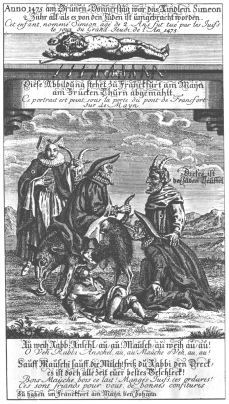
Encyclopaedia Judaica (1971): Anti-Semitism, vol.
3, col. 119-120, allegation having
killed a "Christian" child, in combination with
the Jewish sow
An early 18th-century Frankfort broadsheet combined
the Judensau and the Simon of Trent libels. the
horned Jewish devil urges the Jews to drink the
sow's milk and eat its excrement, "since they are,
after all, your best delicacies."
Text concerning the child:
Anno 1475 am Grünen-Donnerstag war das Kindlein
Simeon 2 Jahr alt, als es von den Juden ist
umgebracht worden.
Diese Abbildung stehet zu Franckfurt am Maÿn am
Brücken Thurn abgemahlt.
French: Cet enfant,nommé Simeon, agé de 2 Ans fut
tué par les Juifs le jour du Grand-Jeudi de l'An
1475.
Ce portrait est peint, sous la porte du pont de
Francfort sur Le Mayn.
[[Engl.: In 1475 on Great Thursday the child Simeon
of 2 years was murdered by the Jews.
This picture is shown in Frankfort on the Main on
the Tower Bridge. This is a copy of it.]]
Text concerning the Jewish Sow:
Au weih Rabbi Anschl, au, au! Mausch, au weih, au,
au!
Sauff Mauschi sauff, die Milch! Friss du Rabbi den
Dreck, es ist doch alle Zeit euer bestes Geschleck!
O Veh Rabbi Anschel, au, au! Maûche o Veh, au, au!
Bois Maûche, bois ce lait! Manges Juifs, ces
ordures! Ces sont friands pour vous, de bonnes
confitures.
[[Engl.: Wow rabbi Anschl, wow, wow! Mausch, wow,
wow!
Drink Mauche, drink the milk! Eat, Jews, eat this
shit! This is the best you can eat, it's your
marmelade]].
|
[The defamation strategy of having sex with
"Christian" women"]
[[In the name of a certain "Jesus" criminal "Christian" Church
claimed that all "Christian" women would be "spiritually the
wives of Our Lord Jesus Christ". By this impossible claim
criminal "Christian" Church invented lots of racist laws
against sexual relations between the religions and between the
races, e.g., against sex between black and white]].
<Erotica
The theme of Jewish sexuality and sensuality, especially in
relation to Christian women, is of early origin. The code of
Spanish law,
Las Siete
Partides, compiled under the supervision of Alfonso X
c. 1265, included a series of laws concerning the Jews. Law IX
is entitled: What penalty a Jew deserves who has intercourse
with a Christian woman.
Jews who live with Christian women are guilty of great
insolence and boldness, for which reason we decree that all
Jews who, hereafter, may be convicted of having done such a
thing shall be put to death. For if Christians who commit
adultery with married women deserve death on that account,
much more do Jews who have sexual intercourse with Christian
women, who are spiritually the wives of Our Lord Jesus Christ
because of the faith and the baptism which they receive in His
name; nor do we consider it proper that a Christian woman who
commits an offense of this kind shall escape without
punishment. Wherefore we order that, whether she be a virgin,
a married woman, a widow, or a common prostitute who gives
herself to all men, she shall suffer the same penalty which we
mentioned in the last law in the Title concerning the Moors,
to which a Christian woman is liable who has carnal
intercourse with a Moor [i.e., confiscation of property,
scourging, or death].> (col. 127-128)

Encyclopaedia Judaica (1971): Anti-Semitism, vol. 3,
col. 127-128, cartoon showing
Jewish grandfathers showing a young naked
"Christian" woman |
|
These examples of pictures of
anti-Semitism are only for documentation.
[[Addition: The Plague - and the expulsions of the
Jews
The four allegations of the defamation strategy of
1. robbery
2. Jewish sow
3. killing children
4. having sex with "Christian" women who were considered the
wives of a certain "Jesus"
were a killing propaganda strategy of criminal racist
"Christian" Church. It can be admitted that there were also
Jewish allegations against non-Jews which are never presented
in Encyclopaedia Judaica.
When the plague came up by the rat flea on the Asian rats
(which were transported in Italian "Christian" commercial
cargo vessels), the "science" of these days could not explain
the illness of the plague and the Jews were given the guilt.
In combination with the defamation strategies before the
mental forces of the racist "Christian" authorities went into
an inexcusable expulsion wave against the Jews. Until now the
"holy" books are not cleaned of the defamations against other
religions. The "religions" and their "holy books" are even
protected with their defamations, and nobody changes the
defamating "holy books" until today...]]
===
Sources
|
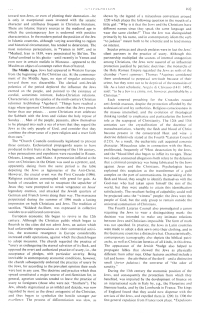
Encyclopaedia Judaica (1971): Anti-Semitism, vol. 3,
col. 101-102
|
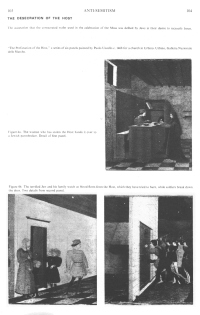
Encyclopaedia Judaica (1971): Anti-Semitism, vol. 3,
col. 103-104
|
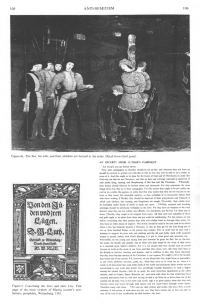
Encyclopaedia Judaica (1971): Anti-Semitism, vol. 3,
col. 105-106
|

Encyclopaedia Judaica (1971): Anti-Semitism, vol. 3,
col. 107-108
|
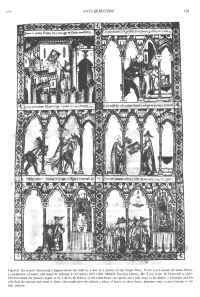
Encyclopaedia Judaica (1971): Anti-Semitism, vol. 3,
col. 109-110
|

Encyclopaedia Judaica (1971): Anti-Semitism, vol. 3,
col. 117-118
|
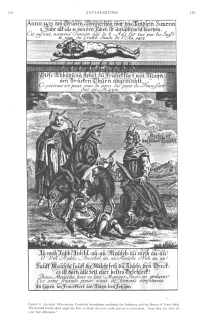
Encyclopaedia Judaica (1971): Anti-Semitism, vol. 3,
col. 119-120 |

Encyclopaedia Judaica (1971): Anti-Semitism, vol. 3,
col. 127-128
|




![Encyclopaedia Judaica (1971):
Anti-Semitism, vol. 3, col. 105-106: The Jew,his wife, and
their children are burned at the [["Christian"]]
stake. Detail from third panel Encyclopaedia Judaica (1971): Anti-Semitism, vol. 3,
col. 105-106: The Jew,his wife, and their children are
burned at the [["Christian"]] stake. Detail from
third panel](d/EncJud_anti-semitism-band3-kolonne105-106-scheiterhaufen-26pr.jpg)

![Encyclopaedia Judaica (1971):
Anti-Semitism, vol. 3, col. 103-104a: The
[[Jewish]] woman who has stolen the Host hands
it over to a Jewish pawnbroker. Detail of first
panel. Encyclopaedia Judaica (1971):
Anti-Semitism, vol. 3, col. 103-104a: The
[[Jewish]] woman who has stolen the Host hands
it over to a Jewish pawnbroker. Detail of first
panel.](d/EncJud_anti-semitism-band3-kolonne103-104a-hostienverkauf-33pr.jpg)
![Encyclopaedia Judaica (1971):
Anti-Semitism, vol. 3, col. 103-104b: The
terrified Jew and his family watch as blood
flows from the Host, which they have tried to
burn, while [["Christian"]] soldiers
break down the door. Two details from second
panel. Encyclopaedia Judaica (1971):
Anti-Semitism, vol. 3, col. 103-104b: The
terrified Jew and his family watch as blood
flows from the Host, which they have tried to
burn, while [["Christian"]] soldiers
break down the door. Two details from second
panel.](d/EncJud_anti-semitism-band3-kolonne103-104b-hostienblut-u-fahndung-32pr.jpg)
![Encyclopaedia Judaica (1971):
Anti-Semitism, vol. 3, col. 117, chair in
Cologne Cathedral from14th century with a Jew
suckling a Jewish sow, and two others feeding
it. [[You can see the pointed Jewish hats]]. Encyclopaedia Judaica (1971):
Anti-Semitism, vol. 3, col. 117, chair in
Cologne Cathedral from14th century with a Jew
suckling a Jewish sow, and two others feeding
it. [[You can see the pointed Jewish hats]].](d/EncJud_anti-semitism-band3-kolonne117-judensau-stuhlrelief-14jh-39pr.jpg)










